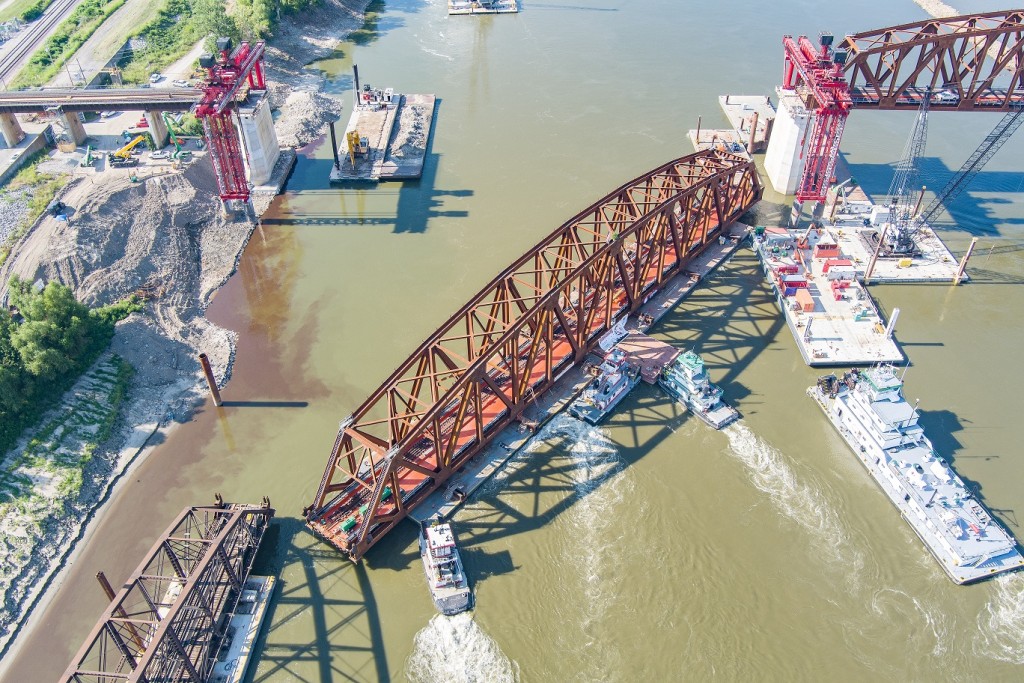
Supply & Demand Chain Executive publication has named the St. Louis Regional Freightway and Terminal Railroad Association of St. Louis (TRRA) as one of the winners of this year’s Top Supply Chain Projects awards. The award recognizes the organizations for the $222 million Merchants Bridge replacement project and the role it will play in optimizing, streamlining, and improving the supply chain.
St. Louis Regional Freightway and TRRA celebrated the official grand reopening of the Merchants Bridge Sept. 15, 2022, following the completion of a landmark project to replace the vital artery that links Missouri and Illinois near downtown St. Louis. The celebration was the culmination of almost a decade of planning and advocacy and four years of reconstruction to modernize this critical infrastructure over the Mississippi River, which is one of the nation’s primary east-west rail corridors serving one of America’s largest rail hubs by car interchange volume and gross tonnage. Dating back to the 1890s and owned by the Terminal Railroad Association of St. Louis (TRRA), the Merchants Bridge serves six Class I railroads, as well as Amtrak, and replacement of the structure had been the bi-state St. Louis region’s top freight infrastructure priority since 2016.
The Merchants Bridge required reconstruction due to speed, clearance, and load restrictions. Not replacing the Merchants Bridge would have resulted in rail traffic being rerouted out of the bi-state St. Louis region, potentially limiting shipping options for area rail-reliant businesses -- increasing costs and losing jobs, and adding stress to an already over-burdened U.S. supply chain network.
The replacement project doubled the capacity of the bridge, allowing two freight trains to cross the bridge at the same time and move freight faster, more cost-effectively, and more reliably than like at larger congested Midwestern rail hubs. The bridge piers were seismically retrofitted, and all new trusses will help ensure reliable rail connections across the Mississippi River into the next century.
The added capacity of the new bridge helps reduce the frequency of mile-long blockages along the St. Louis Riverfront and addresses one of the chokepoints in the nation’s supply chain network, positioning the St. Louis region to accommodate growing freight demands.
TRRA anticipates the region will see more than $370 million in operational savings from reductions in delays, rerouting, and operations and maintenance. The group has a long history of helping ensure the smooth movement of rail freight, but this project represented the first time in TRRA’s 134-year history that it has built a bridge and the project was delivered on budget and ahead of schedule.
“I am confident the economic benefits of this new bridge will be immediate and long-lasting,” said TRRA President Brent Wood. “Our collaboration with the St. Louis Regional Freightway to position this project as the region’s #1 infrastructure priority helped garner the national attention needed to secure federal funding. Delivery of this project is a signature moment to highlight the success of the bi-state, bi-partisan, public-private partnership that made this project possible.”
Bi-State Development launched the St. Louis Regional Freightway in 2014 with the key goal of advancing infrastructure projects that support the movement of freight through the bi-state St. Louis region.
“St. Louis is a world-class freight hub, and we retain this position by constantly looking for ways to improve our freight infrastructure,” said Mary Lamie, Executive Vice President of Multi-Modal Enterprises at Bi-State Development and head of the St. Louis Regional Freightway. “The replacement of the Merchants Bridge benefits all modes of transportation and supports future competitiveness and growth in the region. We salute TRRA and the various partners who helped to deliver the region’s highest priority freight infrastructure project and believe this project demonstrates just how much we can accomplish as a region when we work together.”
“From demand planning and forecasting to implementing the ultimate in warehouse automation, the past 12 months have seen companies within the supply chain and logistics space upgrade, enhance, adopt, and adapt in order to achieve greater efficiency along the chain,” says Marina Mayer, Editor-in-Chief of Supply & Demand Chain Executive and Food Logistics. “That’s why it’s important today’s supply chains run on collaboration.”

Follow us on social media: